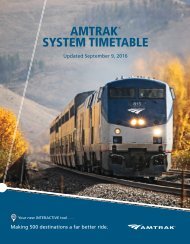Queens
northeast_queens_bus_study_-_final_9-28-15
northeast_queens_bus_study_-_final_9-28-15
Create successful ePaper yourself
Turn your PDF publications into a flip-book with our unique Google optimized e-Paper software.
, Metropolitan Transportation Authority<br />
The MTA evaluates routes to determine if a section should receive additional service in the form of a<br />
short‐turn service. Short‐turns on bus routes are not meant to provide service to areas that are not already<br />
served by the underlying route. That type of service is provided by service route “variants” or a “branch”.<br />
Short‐turns are reevaluated as needed over time to ensure that they are providing the best service for the<br />
route.<br />
Multiple Routes that Operate on the Same Streets<br />
Comments were received that suggested that if more than one bus travels along a portion of a roadway<br />
together, that one of them should either be moved to a parallel street or run limited‐stop spacing service.<br />
There are three principal reasons why more than one bus route might operate on the same street. The<br />
first is that the street may be a high‐density corridor that has a large concentration of residential,<br />
commercial, and community facilities. In Northeast <strong>Queens</strong>, these corridors include Main Street, Kissena<br />
Boulevard, Parsons Boulevard, Hillside Avenue, and Northern Boulevard. Secondly, local and limited<br />
service usually operate in conjunction and provide two different types of service along the same route.<br />
Lastly, the street network in Northeast <strong>Queens</strong> is very complex with a limited number of streets that offer<br />
straight, direct access between neighborhoods, subway stations, and points of interests. Bus service is<br />
more reliable when operated in a straight line than when many turns exist along the route.<br />
Another consideration is that by placing multiple bus routes on one shared corridor, the wait time for a<br />
bus is significantly reduced for many customers who need to travel within that corridor. Splitting bus<br />
routes on different corridors would result in the need to install bus stops and eliminate on‐street parking<br />
for residences and businesses.<br />
Separate Busy Bus Stops from Each Other and Less‐busy Stops<br />
Comments were received regarding the desire for bus stops that are currently located together to be<br />
separated and therefore to provide more room for each individual bus route to be served by its own<br />
dedicated stop. Several comments were received about the combination of stops for popular bus routes<br />
crowding out riders of other buses. It was stated that some buses will drive past a location because the<br />
bus operator believes that the waiting passengers are only waiting there for a different bus. Comments<br />
were received that at evening peak periods, especially at subway stations, there is not enough room on<br />
the sidewalk to accommodate all bus riders waiting for the various bus routes that all pick up in the same<br />
area.<br />
The MTA continues to evaluate the location of bus stops and the ridership at each stop. When a bus<br />
service increases in ridership and additional service is added to accommodate the additional passengers,<br />
the MTA evaluates the stops to look for ways to create a better passenger environment. While bus stop<br />
locations are requested by the MTA, the final determination on location and space allocation is made by<br />
NYCDOT. The MTA works closely with NYCDOT to determine what bus stops can be appropriately adjusted<br />
on a stop‐by‐stop basis. The MTA will continue to adjust bus stops as ridership patterns change.<br />
58



